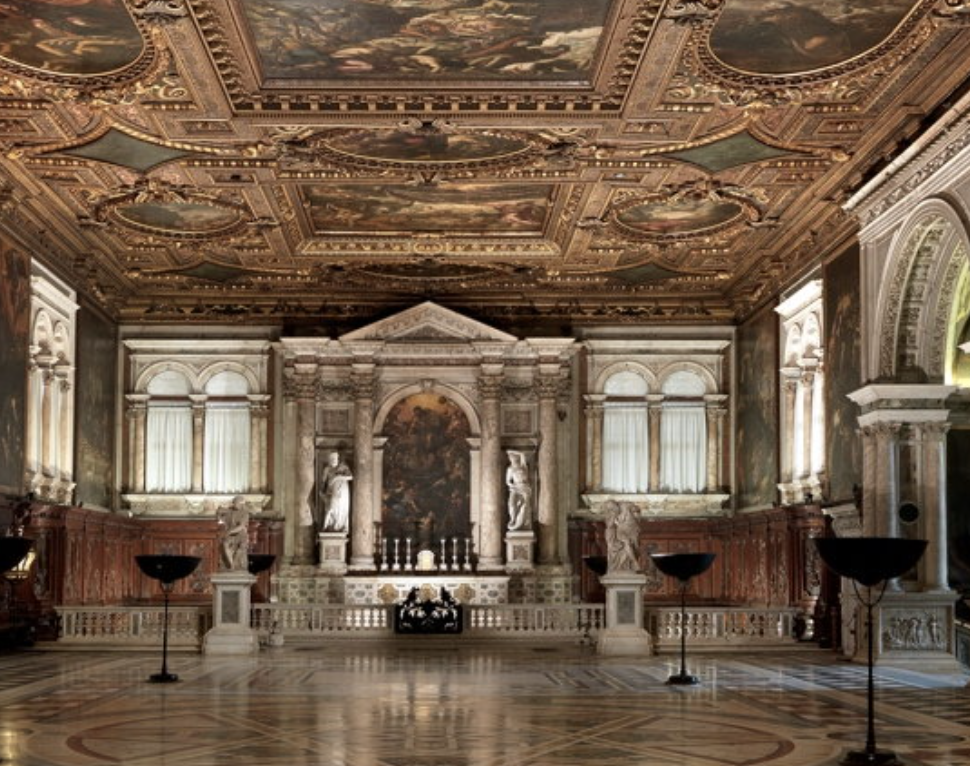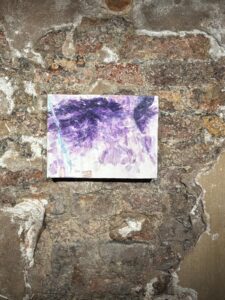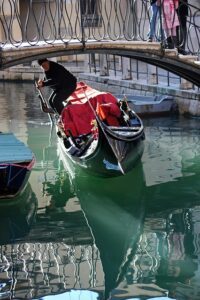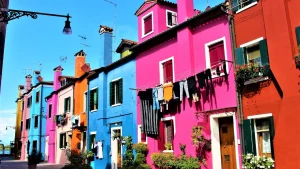Scuola Grande di San Rocco — Tintoretto’s Venetian Masterpiece Hidden in Plain Sight
Venice loves her secrets. Behind every quiet campo and every peeling façade hides a miracle, and one of the greatest sits just a few bridges away from the bustle of St. Mark’s Basilica. Tucked between the scent of espresso and the echo of church bells near the Frari Church lies the Scuola Grande di San Rocco — a building that looks modest from the outside but glows like heaven within.
For lovers of Renaissance art, for travelers who chase goosebumps instead of crowds, this isn’t just another museum. It’s a revelation. Step inside, and you’ll find yourself surrounded — ceiling to floor — by the furious genius of Jacopo Tintoretto, Venice’s own master of lightning and shadow, whose brush seemed powered by divine voltage. This is no gallery. It’s a living sermon in color, a place where paint still seems wet with faith and ambition.
🏛️ A Brotherhood Born from Faith and Fear
The story begins in 1478, when a group of Venetian citizens founded a confraternity — a lay brotherhood of charity and prayer — dedicated to San Rocco, the saint invoked during plague times. Venice, after all, has always been a city in constant conversation with death: her canals once carried trade and contagion in equal measure. San Rocco’s followers promised both medicine for the body and comfort for the soul.
The building we see today rose between 1515 and 1560, all marble calm and Renaissance symmetry. Members met here to organize alms, fund hospitals, and — being Venetians — commission art that could lift the eyes as much as the spirit. But when the Scuola sought to decorate its halls, one restless young painter decided to rewrite the rules of patronage forever.
🎭 Tintoretto: The Lightning of Venice
Jacopo Robusti, nicknamed Tintoretto — “the dyer’s boy” — was born in 1518 a few canals away. He studied briefly with Titian (long enough to irritate him) and spent his career trying to out-paint everyone else in the lagoon. His motto? “Il disegno di Michelangelo e il colorito di Tiziano” — Michelangelo’s drawing with Titian’s color. In other words: he wanted it all.
When, in 1564, the Scuola Grande di San Rocco announced a competition for the ceiling of the Sala dell’Albergo, Tintoretto saw his chance. While rivals submitted polite sketches, Tintoretto skipped the paperwork. He climbed a ladder, installed a finished painting — “Saint Roch in Glory” — directly into the frame, and then, smiling, declared it a gift to the saint.
The judges were stunned. Technically, he’d broken every rule. Spiritually, he’d won. They accepted the “gift,” awarded him the contract, and Tintoretto spent the next two decades turning the entire Scuola into his personal Sistine Chapel — Venetian edition, with extra drama and better lighting.
🖼️ Inside the Scuola Grande di San Rocco: Three Rooms, One Universe
🌒 Sala Terrena — The Entrance into Light and Shadow
Push through the wooden doors, and you step into the Sala Terrena, the ground-floor hall. It’s dim, deliberate, like the prelude to revelation. The canvases — “The Annunciation,” “The Flight into Egypt,” “The Adoration of the Magi” — seem to breathe. Figures emerge from darkness as if searching for God’s light, their faces flickering in candle-warm hues. Tintoretto’s perspective twists; floors tilt, angels dive, reality bends. Stand too long before one painting, and you’ll start to feel the room move with you.
🌅 Sala dell’Albergo — The Crucifixion and the Climax of Faith
Climb the creaking staircase to the Sala dell’Albergo, and prepare to be undone. Here hangs “The Crucifixion” (1565), a torrent of humanity cascading around the cross. Hundreds of figures swirl in chaos — soldiers, thieves, mourners, angels — yet somehow, amidst the storm, Christ remains a beam of light. It’s not a painting; it’s an experience. Even the most skeptical traveler falls silent here. Legend says Tintoretto painted much of it standing on scaffolds through the night, working by candlelight reflected off tin sheets to amplify the glow. The effect still feels electric.
🌞 Sala Superiore — The Ceiling That Touches Heaven
Continue upward to the Sala Superiore, and you’ll find the Bible unfolding overhead like a celestial comic book. “Moses Striking Water from the Rock,” “The Fall of Manna,” “Ezekiel’s Vision.” Angels tumble across gilded clouds; prophets gesture mid-sentence; light darts between them like divine punctuation. A good pair of binoculars — yes, Venetians approve — lets you dive into the brushwork, where you can see fingerprints, grit, even candle soot. It’s Tintoretto whispering across five centuries: “Look closer.”
💬 Stories and Secrets from the Scuola
- During Venice’s plague of 1575, the brotherhood carried the relics of San Rocco through the city. Tintoretto joined the procession barefoot, praying for mercy. Venice survived. The next year, he painted “The Glorification of San Rocco” as thanksgiving.
- Napoleon’s troops used the Scuola as a barracks in 1797. Soldiers allegedly played cards beneath “The Crucifixion.” Later restorers swore the eyes of Christ seemed darker afterward.
- Each August 16 (Venezia’s Festa di San Rocco), locals still gather in front of the building to honor the saint. You’ll see candles flickering on marble steps and the faint sound of hymns floating down the calle — a tradition unchanged since Tintoretto’s day.
🧭 How to Visit the Scuola Grande di San Rocco
📍 Location: Campo San Rocco, San Polo District — right beside the Frari Church (see also Ca’ Rezzonico nearby). A 10-minute walk from the Rialto Bridge.
🚶 Getting There: Take Vaporetto Line 1 or 2 to San Tomà and follow the signs through the back streets — or let our Off-the-Beaten-Path Tour guide you there without getting lost (we promise).
🕰 Opening Hours: Daily 9:30 AM – 5:30 PM (last entry 5 PM). Closed Christmas and New Year’s Day.
🎟 Tickets: Around €10 for adults (€8 reduced). You can buy them at the door or book skip-the-line tickets here for extra ease.
🗣 Language Tips: Labels are in Italian and English; an audio guide is available on-site. We recommend joining our licensed private Venice art tour for context that connects San Rocco with the rest of Renaissance Venice.
✨ Local Tips for Art Lovers
- Arrive Early: Right after opening, you might have the Sala dell’Albergo almost to yourself — a rare miracle in Venice.
- Bring Binoculars: Yes, locals do. You’ll see angels you’d miss with the naked eye.
- Take Your Time: Spend at least 90 minutes here; this is not a checklist stop but a pilgrimage.
- Pair it with the Frari: Next door, the Basilica di Santa Maria Gloriosa dei Frari houses Titian’s “Assumption of the Virgin.” It’s a perfect dialogue between Titian and Tintoretto — Venice’s eternal artistic rivalry.
- Photography: Allowed without flash — but remember you’re standing in a sacred space. Respect the silence.
🌍 Nearby Wonders to Complete Your Day
- Campo San Polo: A vast square where locals chat and children kick soccer balls between Renaissance palazzi.
- Scuola Grande di San Giovanni Evangelista: Another brotherhood rich in art — and blissfully uncrowded.
- Ca’ Rezzonico: A palace-museum celebrating 18th-century Venice — the city’s golden hangover after Tintoretto’s century.
- Rialto Market: Finish your art day with colorful produce, fresh fish, and perhaps a glass of Prosecco from our Cicchetti & Wine Tour.
📚 Did You Know? Tintoretto Trivia You Can Impress Your Friends With
- His nickname “Il Furioso” came from his speed. He painted so fast that assistants once complained they couldn’t keep up mixing paint.
- He kept a human skull in his studio for practice lighting. When the plague struck, he refused to flee Venice — painting through the lockdown centuries before Zoom meetings existed.
- Tintoretto was buried in the Madonna dell’Orto Church in Cannaregio. If you want to pay respects, join our Venice Off-the-Beaten-Path Tour — we’ll show you his tomb and final masterpieces away from the crowds.
💡 Why the Scuola Grande di San Rocco Still Matters
Venice has many rooms filled with beauty, but few that hum with spirit. In San Rocco, you don’t just look at art — you walk into it. Tintoretto’s brush strokes still carry the pulse of a man who believed he could paint the invisible, and for a moment, you believe it too.
While crowds queue for the Doge’s Palace and pose on the Rialto, here in this dimly lit hall you can stand alone before genius — and feel Venice as she once was: brave, faithful, and brilliantly alive.
🎟️ Book Your San Rocco & Frari Art Experience
🚶 Explore Hidden Venice with a Local Guide
Because sometimes the most extraordinary treasures in Venice aren’t found on the water — but on the walls where light still moves.
FAQs About Visiting the Scuola Grande di San Rocco
Is the Scuola Grande di San Rocco worth visiting?
Absolutely. It’s one of Venice’s most extraordinary art experiences — a spiritual and visual journey through Tintoretto’s monumental cycle of paintings. Far quieter than the Doge’s Palace or St. Mark’s Basilica, it offers a powerful glimpse of Renaissance Venice at its artistic peak.
How long should I spend at the Scuola?
Set aside at least 90 minutes. The building has three levels, each filled with vast, immersive canvases. Arrive early for peaceful viewing or later in the afternoon when the crowds fade and the light feels almost cinematic.
What’s the best way to combine the visit with nearby sights?
Pair your visit with the Frari Church right next door to see Titian’s Assumption of the Virgin, or continue to the Scuola Grande di San Giovanni Evangelista for more Venetian masterpieces. To connect the stories and artists, join our Off-the-Beaten-Path Walking Tour — it weaves together Tintoretto, Titian, and the Venice that inspired them both.







